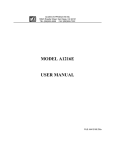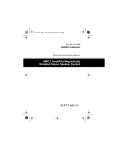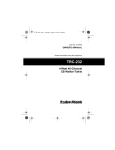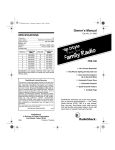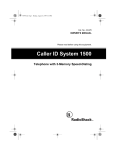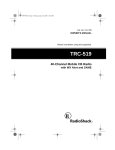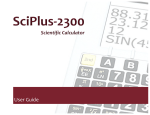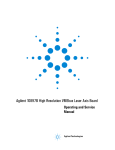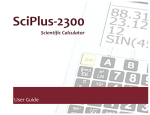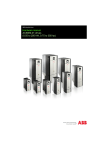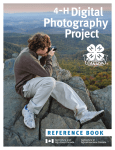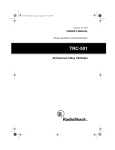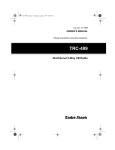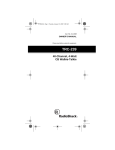Download Radio Shack TRC-488 User's Manual
Transcript
21-1585.fm Page 1 Thursday, August 5, 1999 9:39 AM Cat. No. 21-1585A OWNER’S MANUAL Please read before using this equipment. TRC-488 40-CHANNEL 2-WAY CB RADIO 21-1585.fm Page 2 Thursday, August 5, 1999 9:39 AM FEATURES Your Radio Shack TRC-488 40-Channel 2-Way CB Radio is a high performance citizen’s band radio that also lets you tune to national weather service broadcasts. This CB is perfect for recreational, business, or emergency use. It lets you talk to other people with CBs at home, in their vehicles, or at camp sites. You can also connect optional equipment to your CB, such as a DC power supply and base station antenna to set up a base station in your home. Your CB has the following features: 7-Channel WX Band Receiver — lets you tune to seven national weather frequencies so you can hear your local weather conditions as well as weather forecasts wherever you travel. Emergency Channel Selector — lets you quickly switch to Channel 9 so you can report or monitor emergency situations. Two Ceramic Filters — provide superior channel selectivity and eliminate adjacent-channel interference. Automatic Noise Limiting (ANL) — reduces noise caused by nearby electrical equipment such as motors or automotive ignition systems. LED Channel Display — displays the selected channel (1-40). When channel 9 is selected with the emergency channel switch, the 9 flashes continuously. When a weather channel is selected, the display “blanks-out.” RF Gain Control — lets you adjust the receiver gain to match the strength of the received signal. Universal Mounting Bracket — lets you mount your CB securely in your vehicle or on a table or shelf in your home. PLL (Phase-Locked Loop) Frequency Synthesizer — provides reliable and exact tuning. Important: To use this CB, you must connect a mobile or base station antenna (available at your local Radio Shack store). See “Installing an Antenna” on Page 8. Hysteresis Squelch — automatically adjusts receiver sensitivity to compensate for fading signals and to eliminate signal chopping during reception. For your records, we recommend you record your CB’s serial number in the space below. The serial number is located on the CB’s back panel. Serial No. © 1996 Tandy Corporation. All Rights Reserved. Radio Shack is a registered trademark used by Tandy Corporation. 2 21-1585.fm Page 3 Thursday, August 5, 1999 9:39 AM CONTENTS Installation ............................................................................................................ 4 Mounting the TRC-488 .................................................................................... 4 Mounting the Microphone Holder .................................................................... 5 Connections ......................................................................................................... Connecting the Microphone ............................................................................ Connecting an Optional External Speaker ...................................................... Connecting Power ........................................................................................... Using Vehicle Battery Power .................................................................... Using Standard AC Power ........................................................................ Installing an Antenna ...................................................................................... Adjusting the Antenna’s SWR ......................................................................... 6 6 6 7 7 7 8 9 Operation ............................................................................................................ Setting Squelch ............................................................................................. Using Automatic Noise Limiting .................................................................... Listening to Weather Broadcasts .................................................................. Receiving Transmissions on the Channels ................................................... Transmitting .................................................................................................. 10 10 10 10 11 12 CB Tips ............................................................................................................... Common Uses for a CB Radio ...................................................................... Business Uses ........................................................................................ Personal Uses ........................................................................................ CB Courtesy .................................................................................................. Using Common 10-Codes ............................................................................. 13 13 13 13 13 14 Troubleshooting ................................................................................................ 15 Maximum Range ........................................................................................... 16 Reducing Noise ............................................................................................. 16 Maintenance ....................................................................................................... 17 Replacing the Fuses ..................................................................................... 18 FCC Information ............................................................................................ 18 Specifications .................................................................................................... 19 3 21-1585.fm Page 4 Thursday, August 5, 1999 9:39 AM INSTALLATION MOUNTING THE TRC-488 If you use the TRC-488 as a base station, you can mount it on a desk, shelf, or table. The most common mounting location for the CB is under a vehicle’s dashboard. If you use the TRC-488 in a vehicle, mount it securely to avoid damage to the CB or vehicle or injury to anyone in the vehicle during sudden starts or stops. Follow these steps to mount the CB using the supplied bracket, screws, washers, and knobs. 1. Using the mounting bracket as a template, mark the positions for the screw holes. (illus) When you mount the CB in a vehicle, make sure: • You can easily reach the CB. • Its wires and cables do not interfere with any of the vehicle’s moving parts. • The CB is not directly in front of heating vents. • All wires and cables reach their connection points. 2. In each marked location, drill a hole slightly smaller than the supplied screws. Caution: Be careful not to drill into any objects behind the mounting surface. 3. Using a Phillips screwdriver, attach the mounting bracket to the mounting location with the supplied screws and lock washers. (illus) 4 21-1585.fm Page 5 Thursday, August 5, 1999 9:39 AM 4. Attach the CB to the mounting bracket using the supplied rubber washers and mounting knobs. (illus) MOUNTING THE MICROPHONE HOLDER With a Phillips screwdriver and the supplied screws and washers, attach the supplied microphone holder to the CB’s right side. (illus) 5 21-1585.fm Page 6 Thursday, August 5, 1999 9:39 AM CONNECTIONS CONNECTING THE MICROPHONE 1. Make sure the pins on the microphone cable’s plug are aligned with the holes in the CB’s MICROPHONE jack on the CB’s left side and insert the plug into the jack. Caution: Never pull on the microphone cable. CONNECTING AN OPTIONAL EXTERNAL SPEAKER You can connect an external speaker to the CB. (illus) Notes: • You must use an 8-ohm speaker capable of handling up to 5 watts of power (such as Radio Shack Cat. No. 21-549). 2. Slide the microphone onto the microphone holder. (illus) • The speaker’s cable must have a 1/8-inch plug. To connect an external speaker, simply plug the speaker’s cable into the CB’s EXT jack. (illus) To disconnect the microphone cable, press and hold down the small tab on the microphone plug, then pull out the plug. (illus) 6 Note: When you connect an external speaker, the CB’s internal speaker disconnects. 21-1585.fm Page 7 Thursday, August 5, 1999 9:39 AM CONNECTING POWER Using Vehicle Battery Power Follow these steps to power the CB from your vehicle’s battery. 5. Connect the orange BATT + wire, with in-line fuse, to your vehicle battery’s positive (+) terminal or to a point in the vehicle’s fuse box fuse that provides a continuous source of 12 volts even when the ignition is turned off. 1. Make sure the CB is turned off. 2. Disconnect the cable from your vehicle battery’s negative (–) terminal. 3. Connect the black GROUND wire to a metal part of your vehicle’s frame. (illus) This connection is for last-channel memory backup. (illus) 6. Reconnect the cable to the vehicle battery’s negative (–) terminal. Using Standard AC Power Note: Be sure the metal part is not insulated from the vehicle’s frame by a plastic part. 4. Connect the red TO SWITCHED ACCESSORY wire, with in-line fuse, to a source of voltage that turns on and off with the ignition switch, such as a spare accessory terminal in your vehicle’s fuse box. You can power the CB from a standard AC outlet using a 12-volt DC power supply (such as Cat. No. 22-120) Caution: Most 12-volt DC power supplies plug into a standard AC outlet to produce DC power. Before connecting your CB to a 12-volt DC power supply, read and follow the instructions included with the power supply. 1. Make sure the CB is turned off. (illus) 2. Make sure the power supply is turned off. 7 21-1585.fm Page 8 Thursday, August 5, 1999 9:39 AM 3. Connect the black GROUND wire to the DC power supply’s negative (–) terminal. INSTALLING AN ANTENNA Caution: To prevent damage to your CB, you must connect an antenna to the CB before you operate it. (illus) Note: Your local Radio Shack store sells a variety of CB antennas for both mobile and base-station use, and coaxial antenna cable and connectors. both the red TO SWITCHED ACCESSORY and orange BATT + wires, with in-line For the best performance, consider the following when deciding on an antenna and its location: fuses, to the DC power supply’s positive (+) terminal. • The antenna and cable should be as far as possible away from sources of electrical noise. 4. Connect • The antenna should be located vertically and as high as possible. (illus) Follow these steps to connect an antenna. 1. Follow the mounting instructions that come with the antenna. These wires supply power to operate your CB and backup the lastchannel memory. 5. Connect the DC power supply to a standard AC outlet. 8 Warning: Use extreme caution when you install or remove a base station CB antenna. If the antenna starts to fall, let it go! It could contact overhead power lines. If the antenna touches the power line, your contact with the antenna, mast, cable, or guy wires can cause electrocution and death. Call the power company to remove the antenna. DO NOT attempt to do so yourself. 21-1585.fm Page 9 Thursday, August 5, 1999 9:39 AM 2. Route the cable between the antenna and the CB. 3. Connect the cable to ADJUSTING THE ANTENNA’S SWR the ANTENNA jack on the back of the CB. (illus) Caution: Do not run the cable: To achieve your CB’s maximum range, the antenna’s Standing Wave Ratio (SWR) should be adjusted using an SWR meter (not supplied). Follow the instructions supplied with the SWR meter and antenna to adjust your antenna’s SWR to the lowest possible value. SWR values of 2.0:1 are generally acceptable, with readings of 1.5:1 or lower being more desirable. • Over sharp edges or moving parts that might damage the cable • Next to power cables or other CB antenna cables • Through the engine compartment or other areas that produce extreme heat 9 21-1585.fm Page 10 Thursday, August 5, 1999 9:39 AM OPERATION SETTING SQUELCH Caution: Do not attempt to use your CB without first connecting it to an antenna. 1. Turn VOLUME clockwise until it clicks to turn on the CB, then set it to about halfway between the minimum and maximum settings. The CB tunes to the last-selected channel. USING AUTOMATIC NOISE LIMITING If you hear low-level popping noises while receiving transmissions, slide ANL/OFF to ANL to turn on the automatic noise limiting circuit. Otherwise, leave ANL/OFF set to OFF (see “Reducing Noise” on Page 16). (illus) (illus) 2. Turn SQUELCH fully counterclockwise. You hear background noise and the green BUSY LED lights. (illus) 3. Adjust VOLUME to a comfortable setting. 4. Turn SQUELCH clockwise just until the background noise stops. Note: To receive weaker transmissions, turn SQUELCH counterclockwise. 10 LISTENING TO WEATHER BROADCASTS The FCC (Federal Communications Commission) has allocated 11 channels for use by the National Oceanographic and Atmospheric Administration (NOAA). NOAA broadcasts your local forecast and regional weather information on one or more of these channels in your area. 21-1585.fm Page 11 Thursday, August 5, 1999 9:39 AM Your TRC-488 receives the following frequencies available to NOAA: 162.400 162.425 162.450 162.475 MHz MHz MHz MHz 2. To select the emergency channel (9), slide CH9/OUT to CH9. CH9 flashes on the display. 162.500 MHz 162.525 MHz 162.550 MHz To select one of the seven available weather channels, set the mode selector to W1-W7. The yellow WX LED lights. (illus) (illus) Important: The emergency channel is used for reporting and monitoring emergency information about accidents, hazardous road conditions, etc. Do not use Channel 9 for non-emergency messages. Note: You cannot receive transmissions on Channel 9 when the mode selector is set to any of the W1-W7 weather channels. RECEIVING TRANSMISSIONS ON THE CHANNELS After setting squelch, follow these steps to receive transmissions. 3. To select one of the other 39 channels, slide CH9/OUT to OUT. Turn CHANNEL to select the desired channel. The channel number appears on the LED channel display. 1. Set the mode selector to CB . (illus) (illus) 11 21-1585.fm Page 12 Thursday, August 5, 1999 9:39 AM 4. If necessary, turn RF.GAIN clockwise to increase the signal sensitivity. 4. Hold the microphone 2 or 3 inches from your mouth, then press and hold down the microphone talk button and speak into the microphone in a normal voice. The red TX indicator lights. (illus) (illus) To turn off the TRC-488, turn VOLUME counterclockwise until you hear it click. (illus) TRANSMITTING We recommend you spend some time receiving transmissions before you try to transmit a message yourself. Follow these steps to transmit. 1. Set the mode selector to CB . 2. Slide CH9/OUT to OUT. 3. Turn CHANNEL to the desired channel. 12 Note: Do not speak too loudly when transmitting. It does not make your signal any stronger, and might distort your transmission. 5. When you finish transmitting, release the microphone talk button. You can now receive transmissions. 6. To turn off the TRC-488, turn VOLUME counterclockwise until you hear it click. 21-1585.fm Page 13 Thursday, August 5, 1999 9:39 AM CB TIPS Like any other activity, CB radio has its rules and courtesies. The following tips will help you get the most enjoyment out of your CB. COMMON USES FOR A CB RADIO Business Uses • Truck drivers and delivery personnel use it to get road and traffic conditions and obtain assistance in locating destinations. A CB is good company on those “long hauls.” • Construction crews use it to call for additional materials or for coordinating the activities of different work crews. • To security officers, a CB is more than a convenience — it is a must for both safety and efficiency. Personal Uses • Keep in touch with home while driving to work, to the store, or to a social activity. Let your family know you are tied up in traffic or that you will stop by the store on the way home. plan a get-together. You can even meet new friends this way. • Ever have car trouble or run out of gas on the highway? It’s a relief to be able to use the CB to call for assistance. • Camping, fishing, or other sports are more fun with a CB. Locate a buddy or find out “what’s cooking” back at camp. CB COURTESY Please follow these guidelines of radio courtesy when using your CB. • Wait for a pause in someone else’s transmission before you ask for a break. • If you do not receive an answer to your call after a second attempt, sign off and wait several minutes before trying again. • Do not hold down the microphone talk button when you are not talking. (This is called dead keying.) • Assist callers with directions, information about road conditions, and any other reasonable requests. • CBs are great on trips to communicate with family members while they are in separate cars. • Contact friends or neighbors — find out “what’s happening” or 13 21-1585.fm Page 14 Thursday, August 5, 1999 9:39 AM USING COMMON 10-CODES Citizen’s band operators have largely adopted the 10-codes for standard questions and answers. These codes permit faster communication and better intelligibility in noisy areas. The following table lists some of the more common codes and their meanings. Code Meaning 10-1 Receiving poorly/Cannot understand your message 10-2 Receiving well/Your signal is good 10-3 Code Meaning 10-18 Urgent 10-19 Contact ______________ 10-20 What is your location? Stop transmitting 10-21 Call _________ by telephone 10-4 OK/Message received and understood 10-22 Cancel/disregard previous message 10-5 Relay information to _______ 10-23 Arrived at the destination 10-6 I am busy or are you busy? 10-24 Assignment complete 10-7 Out of service 10-25 Meet ________________ 10-8 In service 10-26 Estimated time of arrival is __________ 10-9 Repeat last message 10-29 Check records 10-10 Negative/No or standing by 10-30 10-11 __________ in service Use caution/Unauthorized use of radio 10-12 Stand by 10-31 Pick up 10-13 Request/report road/weather conditions 10-33 Emergency/Clear the channel 10-14 Information 10-34 What time is it? 10-15 Message delivered 10-36 The correct time is ________ 10-16 Reply to message 10-41 Switch to Channel ________ 10-17 En route 14 21-1585.fm Page 15 Thursday, August 5, 1999 9:39 AM TROUBLESHOOTING If your CB is not working as it should, follow the suggestions below to try to eliminate the problem. If the CB is still not working properly, take the CB to your local Radio Shack store for assistance. Problem Trouble with reception. Solution • Be sure the CB is turned on. • Be sure VOLUME is turned up. • Be sure SQUELCH is adjusted properly. • Be sure the microphone is securely connected to the CB. • Be sure the antenna cable is securely connected to both the antenna and the CB. Trouble with transmission. • Be sure the microphone is securely connected to the CB. • Extend the antenna to its full length. • Clean and tighten all connectors. • Be sure you are fully pressing the microphone talk button. • Be sure the antenna cable is securely connected to both the antenna and the CB. No channel selection. Be sure CH9/OUT is set to OUT. CB does not work at all. Check the power supply (either vehicle or standard AC) and in-line fuses (replace only with identical fuses; see “Replacing the Fuses” on Page 18). 15 21-1585.fm Page 16 Thursday, August 5, 1999 9:39 AM MAXIMUM RANGE The maximum range and quality of CB transmissions vary depending on: • The type and quality of antenna used. • The height of the antenna’s mounting location (the higher the antenna, the better the reception). • The surrounding terrain (mountains and tall buildings limit the range). • The weather conditions. • The number of nearby CBs operating on the same channel. • The standing wave ratio (SWR) between the antenna and the CB. You can set the SWR by using an SWR tester (such as Radio Shack Cat. No. 21-523). Follow the instructions that come with the SWR tester. REDUCING NOISE The Automatic Noise Limiting (ANL) circuit helps keep background noise to a minimum. However, strong sources of noise, such as your vehicle’s ignition, another radio, or spark plugs may be more than the circuit can compensate for. 16 If you operate the TRC-488 with the vehicle’s engine off, you should not have any problems with noise. If you use the CB with the engine on, you can determine the source of the noise by turning off the engine and operating the CB with the ignition set to ACC. If most or all of the noise goes away, the problem is in your vehicle’s ignition or electrical system. Here are a few hints to help you reduce or eliminate such noise: • Replace old ignition wires with new, high-voltage, noise-suppression wires. • Install noise suppressors on your spark plugs, or install new spark plugs that have built-in suppressors. • Be sure that the ground connection (black wire) is secure. If problems persist, check your alternator/generator, regulator, and gauges. Noise from these sources can be reduced or eliminated using bypass capacitors at the various output voltage points. Your local Radio Shack store has a wide selection of noise-suppression accessories. 21-1585.fm Page 17 Thursday, August 5, 1999 9:39 AM MAINTENANCE Your TRC-488 40-Channel 2-Way CB Radio is an example of superior design and craftsmanship. The following suggestions will help you care for your CB so you can enjoy it for years. Keep the CB dry. If it gets wet, wipe it dry immediately. Liquids might contain minerals that can corrode the electronic circuits. Handle the CB gently and carefully. Dropping it can damage circuit boards and cases and can cause the CB to work improperly. Use and store the CB only in normal temperature environments. Temperature extremes can shorten the life of electronic devices and distort or melt plastic parts. Keep the CB away from dust and dirt, which can cause premature wear of parts. CLEANER Wipe the CB with a damp cloth occasionally to keep it looking new. Do not use harsh chemicals, cleaning solvents, or strong detergents to clean the CB. Modifying or tampering with the CB’s internal components can cause a malfunction and might invalidate your CB’s warranty. If your CB is not performing as it should, take it to your local Radio Shack store for assistance. 17 21-1585.fm Page 18 Thursday, August 5, 1999 9:39 AM REPLACING THE FUSES FCC INFORMATION The TRC-488’s red wire 2-amp in-line fuse helps protect your CB from power surges and short-circuits. If the fuse has blown, replace it with a 2-amp, fast-acting glass fuse (such as Cat. No. 270-1007). The Federal Communications Commission (FCC) does not require you to have a license to operate this CB. However, the FCC does require you to read and know Part 95 of FCC Rules . These rules apply to the operation of a class D CB. A copy of these regulations is included with your CB. The orange wire’s 1-amp in-line fuse helps protect your CB’s memory channel backup from power surges and short-circuits. If the fuse has blown, replace it with a 1-amp, fast-acting glass fuse (such as Cat. No. 270-1005). Follow these steps to replace either fuse. 1. Make sure the power source and CB are both off. 2. Hold the fuse holder by both ends, push the fuse holder ends together, then turn counterclockwise and release either end. The fuse holder opens. (illus) Warning: Do not open your CB to make any internal adjustments. Internal adjustments and/or modifications can lead to illegal operation as defined by Part 95 of FCC Rules. Such illegal operation can lead to very serious consequences. To be safe and sure: • Never open your CB’s case. • Never modify your CB. Your CB might cause TV or radio interference even when it is operating properly. To determine whether your CB is causing the interference, turn off your CB. If the interference goes away, your CB is causing the interference. Try to eliminate the interference by: • Moving your CB away from the receiver. 3. Replace the fuse with one of the same type and rating. 4. Push the fuse holder ends together, then turn the large end clockwise. The fuse holder closes. 18 • Contacting your local Shack store for help. Radio If you cannot eliminate the interference, the FCC requires that you stop using your CB. 21-1585.fm Page 19 Thursday, August 5, 1999 9:39 AM SPECIFICATIONS RECEIVER Weather Frequency Coverage .............................................................162.400 MHz 162.425 MHz 162.450 MHz 162.475 MHz 162.500 MHz 162.525 MHz 162.550 MHz Frequency Coverage .................................................. All 40 CB Channels (Class D) 26.965 to 27.405 MHz Sensitivity ............................................................0.7 µV or better for 10 dB (S+N)/N Adjacent Channel Rejection .......................................................... 50 dB (at 10 kHz) Audio Output.............................................................................. 4.5 Watts (Nominal) Frequency Response ............................................................................450-2500 Hz Intermediate Frequency...............................................................1st IF: 10.695 MHz 2nd IF: 455.00 kHz Cross Modulation..............................................................................................50 dB Squelch.................................................................... Adjustable from 0.6 µV to 1 mV TRANSMITTER Frequency Coverage .................................................. All 40 CB Channels (Class D) 26.965 to 27.405 MHz Output Power......................................................................4 Watts (FCC Maximum) Type of Modulation ............................AM Double-Sideband, Full Carrier Modulation Modulation Capability .......................................................................................+90% Spurious Emission ......................................................................... Less than –65 dB Frequency Tolerance ..................................................................................... 0.002% Antenna Impedance ..................................................................................... 50 Ohm Current Drain (13.8 volt supply)....................................... 1 Amp with No Modulation 1.5 Amps with Full Modulation 19 21-1585.fm Page 20 Thursday, August 5, 1999 9:39 AM GENERAL Power Requirements ........................................... 12-16 Volts DC, Negative Ground Dimensions .......................................................... 113/16 ¥ 513/16 ¥ 7 1/2 Inches (HWD) (46 ¥ 147 ¥ 190 mm) Weight ............................................................................................... 2 lb 2 oz (1 Kg) Specifications are typical; individual units might vary. Specifications are subject to change and improvement without notice. RADIO SHACK LIMITED WARRANTY This product is warranted against defects for 90 days from date of purchase from Radio Shack company-owned stores and authorized Radio Shack franchisees and dealers. Within this period, we will repair it without charge for parts and labor. Simply bring your Radio Shack sales slip as proof of purchase date to any Radio Shack store. Warranty does not cover transportation costs. Nor does it cover a product subjected to misuse or accidental damage. EXCEPT AS PROVIDED HEREIN, RADIO SHACK MAKES NO EXPRESS WARRANTIES AND ANY IMPLIED WARRANTIES ARE LIMITED IN DURATION TO THE DURATION OF THE WRITTEN LIMITED WARRANTIES CONTAINED HEREIN. Some states do not permit limitation or exclusion of implied warranties; therefore, the aforesaid limitation(s) or exclusion(s) may not apply to the purchaser. This warranty gives you specific legal rights and you may also have other rights which vary from state to state. We Service What We Sell 9/94 RADIO SHACK A Division of Tandy Corporation Fort Worth, Texas 76102 10A6 Printed in Thailand




















